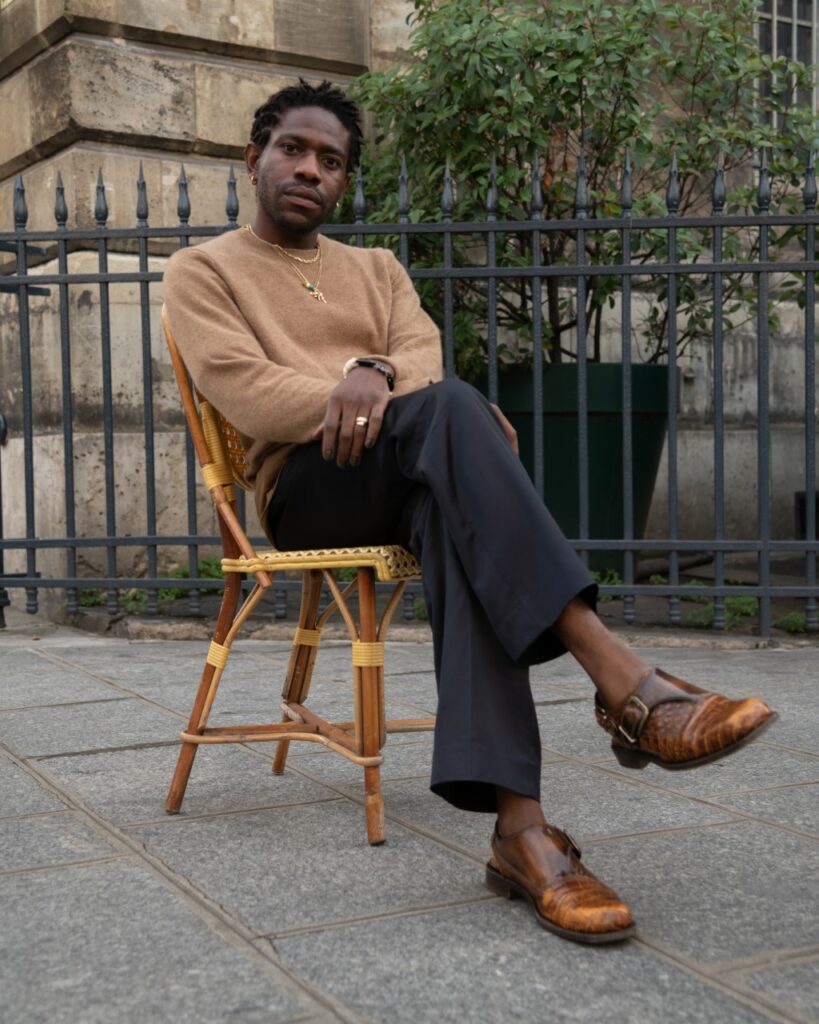Kenneth Ize’s ‘New Dawn’

Kenneth Ize’s latest outing is a jubilant, colourful homage to the pan-African experience and transatlantic narratives, awash with glistening lurex knitwear and woven graphic stripes. With references to Ghana’s Cape Coast, South African political exile Miriam Makeba, and jazz by the musician cktrl, Ize illustrates a cross-current of culture and personal memory through alluring fashion and novel fabrication.
The ensuing collection is a sophisticated expression of the subject matter. The striking, lustrous palette is devised to rally against damaging racist and classist perceptions of African countries while boubou-inspired dress, Nigerian beading, and Dutch wax demonstrate his compulsion to represent the best African design has to offer. Sinuous silhouettes and stripe patterns elongate the body and the movement of fabric is carefully studied to achieve elegant panache.
“I really focus on making women so beautiful,” said Ize speaking over Zoom from his Lagos studio. “Expressing them expressing their feeling through clothes is what I’m trying to do.”
This collection is more optimistic. How did that come to be?
This season is very colourful. It’s taking from your roots but making it new. As a designer, I’m trying to think forward. I can’t really forget about the last collection because it means so much to me and my feelings, but I also to try to see where I am now. It feels like a new dawn and that’s the collection’s title. It feels like things [will] change if we believe in ourselves. If we also do the right things, it brings some positive change.
What was the starting point?
I’m speaking about the Cape Coast and Gold Coast in Ghana, where the slaves were shipped to Europe. I’ve had different conversations in Nigeria with young people and they still don’t know about this history. I feel like this is important to speak about because it’s what has happened. It’s part of our history, it’s part of what makes us. This is the thing that I’m trying to change. I don’t want to be erased. It’s about also teaching the history of that time. It’s not specifically a sad thing to talk about; it’s just more creating more awareness. I did a lot about gold from Ghana. As an African person, I’m trying to still understand where all these things are going; but I don’t know where it’s going to go. As an artist, I need to show my own approach towards these things, like how gold should work now.
How did this exploration feed into the collection?
I’m focusing on how I can see everything sparkling and joyful and glamorous. I feel like gold is actually the main dominant colour this season. I’m so happy I will be working with gold because we don’t have the self-confidence to use it. When it’s getting too shiny, it’s like “Oh, my God, I have to shine; but it looks cheap.” Never in my life did I think I would actually make anything in gold.
Could you speak to the fabrication?
I’ve used lurex in the weaving. I have developed this graphic stripe pattern that is very graphic but feels very ethnic, and very traditional – but at the same time, very modern. I’ve gone into a lot of Dutch wax archives and just recreated my own prints as a pan-Africanist and as a modern African person.
How do you balance tradition and modernity?
Honestly, sometimes I’m confused because I didn’t know where the balance is. I can ask my European friends or my sister, and people who work with me, “Is this too African? Is this too European?” I started doing that just this season but I never used to be like that, which is kind of funny. I would have always said, “This is who I am.” I’ve grown up in two different places. I’ve had the most important years of my life in Europe. When I was a kid I travelled away from Nigeria with my parents and I hadn’t been home for a very long time until I started the brand. That sense of being a pan-Africanist is what makes it that way, I guess. And there’s a lot of us right now.
How do you hope women respond to this work?
I see women like God. I’m not in a space to talk about women, you know because I’m not going through menstrual pain every month. I don’t have to carry a child for nine months. It’s not about how strong you are physically in your body. It’s actually an inner soul; I want people to see that and feel that it’s very important to listen to you or feel your inner soul first. When I design, I think, “How do I feel like my mom is safe when I’m not even there?”, or “How do I feel like my sister is safe when I’m not there?” That’s what I’m trying to speak about. I’m trying to just make sure that people really understand that women are very powerful.



